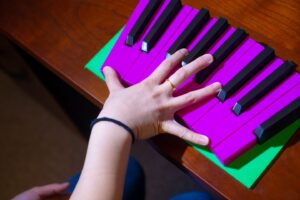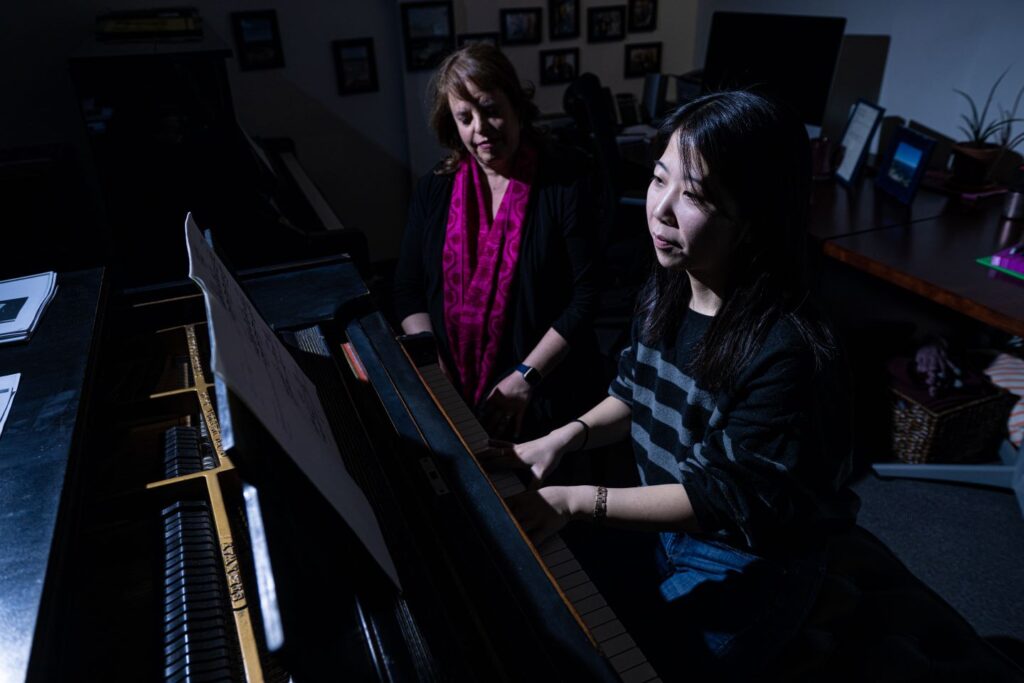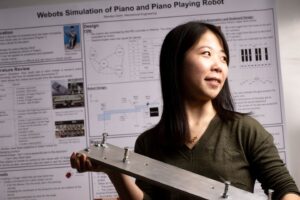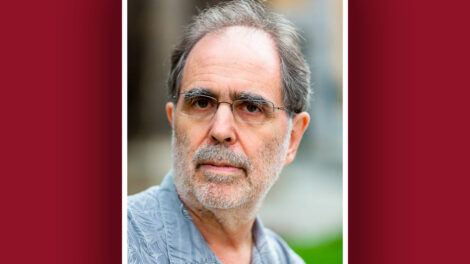Harmonizing inclusivity and sound, a new keyboard emerges
By Bryan Hay
In a bold expression of Lafayette’s engineering and liberal arts tradition, pianist-mechanical engineer Manaka Gomi ’23 is designing a keyboard that’s accessible to musicians with smaller hands while reimagining the instrument’s acoustical possibilities.

Manaka Gomi ’23 demonstrates her curved keyboard
Following in the keyboard alteration tradition of Chopin, Liszt, and even Judy Jetson, the musical member of Hanna-Barbera’s iconic futuristic family, Gomi is creating a curved keyboard, allowing a pianist with a smaller handspan to more comfortably reach a tenth, an interval that’s often demanded in Romantic repertoire and out of reach for many pianists.
The project has two principal goals. One involves choosing materials to create and characterize a novel sound; the second is to design an arched keyboard to relax the thumb-to-pinkie stretch.
A mechanical engineering and music double major, Gomi is bringing both disciplines to bear on her project.
“The keyboard is standard across the world. And if you have smaller hands, it’s harder to play sometimes,” she says. “I want it to be more inclusive.”
Her Lafayette piano instructor, Prof. Holly Roadfeldt, knows all about the technical limitations of the standard keyboard when approaching certain repertoire. With smaller hands, too, she’s been a supportive and sympathetic collaborator as Gomi continues to refine her prototype keyboard.

Manaka Gomi ’23 and her piano instructor, Prof. Holly Roadfeldt
“In almost all of the works from the standard repertoire, a handspan of a ninth is required, but it is common for composers, like Rachmaninoff and Brahms, to include an interval of a tenth. Manaka and I can only reach that ninth,” she explains. While string instruments come in smaller sizes, the pianoforte is unforgiving in its standard design.
“What that means is that you have to manipulate certain passages,” Roadfeldt says. “When the composer notates two pitches to be played simultaneously and your hand does not reach that far, you have decisions to make. Do I break it? Do I roll it? Do I revoice it? Do I take it with another hand? There’s problem-solving involved.”
She and Gomi often discuss the relevance of music history in the project and how Chopin and Liszt, both contemporaries and titans of the Romantic era, worked with piano manufacturers to develop keyboards that would match the technical demands of their compositions. Even the Jetsons’ diminutive daughter jams on a curved keyboard in her Gleep Gorp rock band.
Gomi’s keyboard will make the tenth span more manageable. In her mechanical engineering world, she has already designed and built a hammer mechanism set in a block of aluminum, a diversion from wood, and chosen a bronze guitar string instead of traditional steel piano wire to achieve a unique amplification of sound. She chose these materials after extensive testing and analysis of the sounds made by different materials. Gomi has already produced a sample of her curved keyboard using a 3D printer in Leopard Works.
“When I play it, I can feel the vibration,” she says. “The vibration is also amplified through this aluminum board.”
“Manaka is a very special student with a very particular set of skills,” says Jenn Rossmann, professor of mechanical engineering and Gomi’s academic adviser. “This project really allows her to use what she knows already, as an engineer and a musician, and to learn new things in the completion of the project.”
A classically trained pianist herself, Rossmann notes that Gomi’s design also aims to make the instrument more portable.

Manaka Gomi ’23 and aluminum sound board
“A grand piano is not something you can just put in the back of your car and take to your next gig. So portability was one design objective, along with inclusion,” says Rossmann, adding that Gomi’s experimentation with resonant frequencies to attain certain warm, clear, or crisp articulations unites both mindsets and vocabularies between engineering and music.
“There’s no hierarchy between these two disciplines; we are equal partners. We are appreciating that there’s certain kinds of expertise in each of these fields, and Manaka is the link and the translator between them,” Rossmann says.
“This isn’t about how to use engineering to only serve music, or vice versa. This is a true interdisciplinary conversation that she is able to facilitate because of her fluency in both,” she adds.
As someone who appreciates and researches how sounds can be altered, Kirk O’Riordan, a composer, performer, and associate professor of music and director of bands, has been a fan of Gomi’s ever since she enrolled in three of his music courses.
“She’s an outstanding player, and I’m very happy to support her,” he says. “Her project is just fascinating, dealing with different ways of shaping the keyboard as an interface device to create a variety of different sounds. As a composer, that automatically has a great deal of appeal to me. I love sound and love how it can be manipulated in expressive ways. So, I think it was a natural fit to help out with Manaka on the music side of this project.”
He describes Gomi’s keyboard project as the epitome of Lafayette’s tradition of combining engineering and the humanities.
“I don’t know how it gets any better, frankly,” O’Riordan says. “You’re using engineering to facilitate the creation of art. So much of what is music is about engineering anyway. If engineering starts with problem-solving, composition also starts with problem-solving. What do you want to say? How are you going to say it? What materials are you going to use? How do those materials complement each other and support their own weight? That’s ultimately the combination of engineering and humanities.”
Back at Williams Center for the Arts, Gomi is in Roadfeldt’s studio sitting at a baby grand, playing “Rain Tree Sketch” by Toru Takemitsu (1930-1996), haunting in its beauty and revealing Gomi’s musicianship and technical abilities.
A pianist for most of her life, Gomi has been accepted into the Ph.D. program in mechanical engineering at Stanford University and plans to continue taking piano lessons during graduate school. Chopin is her favorite composer.
“And I’m interested in composing, too. I want to compose using a unique sound,” she says. “I’m hoping this work will make music more inclusive and raise many possibilities of different timbres and sound textures in the piano. It’s been a journey of exploration.”

